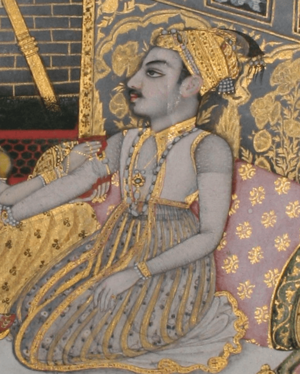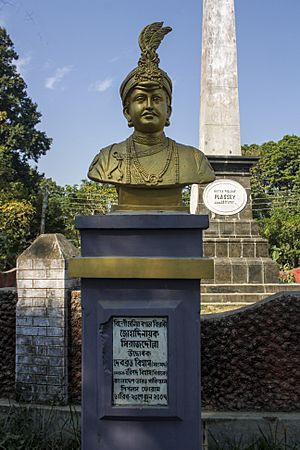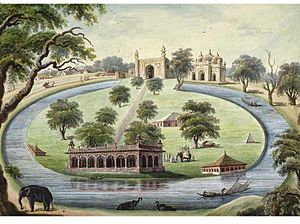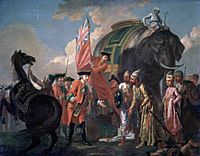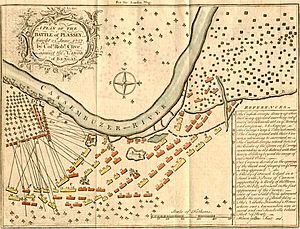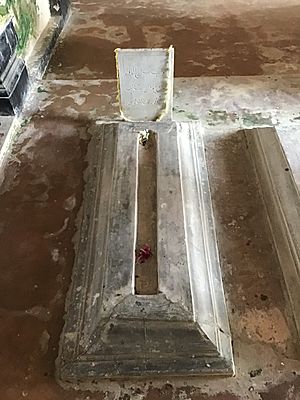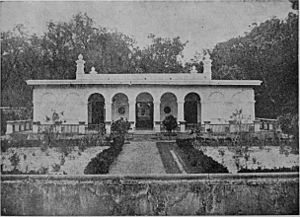Siraj ud-Daulah facts for kids
Quick facts for kids Nawab Siraj-ud-Daulah |
|||||
|---|---|---|---|---|---|
| Mansur-ul-Mulk (Victory of the Country) Siraj ud-Daulah (Light of the State) Hybut Jang (Horror in War) Nawab of Bengal |
|||||
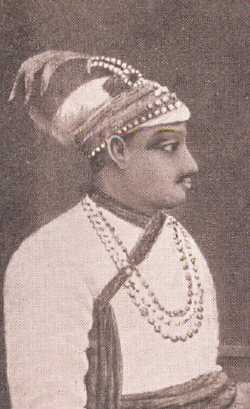
Siraj-ud-Daulah
|
|||||
| Nawab Nazim of Bengal and Bihar | |||||
| Reign | 9 April 1756 – 23 June 1757 | ||||
| Predecessor | Alivardi Khan | ||||
| Successor | Mir Jafar | ||||
| Born | 1733 Murshidabad, Bengal Subah |
||||
| Died | 2 July 1757 (aged 23–24) Murshidabad, Bengal Presidency |
||||
| Burial | Khushbagh, Murshidabad | ||||
| Spouse |
|
||||
| Issue | Umme Zohra (Qudsia Begum) | ||||
|
|||||
| Father | Zain ud-Din Ahmed Khan | ||||
| Mother | Amina Begum | ||||
| Religion | Shia Islam | ||||
| Military career | |||||
| Allegiance | |||||
| Service/ |
Nawab of Bengal | ||||
| Rank | Nawabzada, Nawab | ||||
| Battles/wars | Maratha invasions of Bengal Battle of Plassey |
||||
Mirza Muhammad Siraj-ud-Daulah (Persian: میرزا محمد سراج الدوله; 1733 – 2 July 1757) was the very last independent ruler, known as the Nawab of Bengal. His time as ruler ended when the East India Company began its control over Bengal. This event also marked the start of British rule across much of the Indian subcontinent.
Siraj became the Nawab of Bengal in April 1756. He was only 23 years old. He took over after his grandfather, Alivardi Khan. Sadly, Siraj was betrayed by his own army commander, Mir Jafar. Because of this betrayal, Siraj lost the important Battle of Plassey on June 23, 1757. After this battle, the East India Company, led by Robert Clive, took control of Bengal.
Contents
Who was Siraj-ud-Daulah?
Siraj-ud-Daulah was born in 1733. His parents were Mirza Muhammad Hashim and Amina Begum. His mother, Amina Begum, was the youngest daughter of Alivardi Khan. Alivardi Khan was a very important leader.
Siraj was considered a special child in his family. His grandfather, Alivardi Khan, loved him very much. Siraj grew up in the Nawab's palace. He received the best education and training to prepare him to become a future ruler. He even joined his grandfather in military campaigns against the Marathas when he was young.
In 1750, Siraj briefly rebelled against his grandfather. He took control of Patna. However, he quickly surrendered and was forgiven. In May 1752, Alivardi Khan officially named Siraj as his successor. Alivardi Khan passed away on April 9, 1756, at the age of eighty.
Becoming the Nawab of Bengal
When Siraj ud-Daulah was named Nawab, some people in his family and court became jealous. His aunt, Ghaseti Begum, and important figures like Mir Jafar and Jagat Seth were unhappy. Ghaseti Begum had a lot of wealth and power. Siraj ud-Daulah took her wealth from Motijheel Palace and placed her under guard.
The new Nawab also changed many high-ranking government positions. He gave these jobs to people he trusted. For example, Mir Madan became the army's paymaster, replacing Mir Jafar. Mohanlal became a very influential court official. Siraj also dealt with his cousin, Shaukat Jang, who was killed in a fight.
Why did Siraj ud-Daulah fight the British?
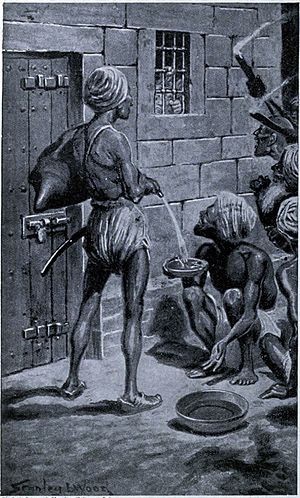
During this time, the British East India Company was growing stronger in Bengal. Siraj ud-Daulah became upset with their increasing power. He believed they were trying to cause trouble in his court. He had three main complaints against the Company:
- First, they built stronger defenses around Fort William without his permission.
- Second, they misused their trading rights. This meant the government lost a lot of money from taxes.
- Third, they protected some of his officers who had stolen government money.
So, when the East India Company continued to build up Fort William in Calcutta, Siraj ud-Daulah ordered them to stop. The Company did not listen. In response, Siraj attacked and captured Calcutta in June 1756. The British prisoners were held in a small prison cell. Due to confusion, many of them sadly died overnight. This event is known as the Black Hole of Calcutta.
Later, a British official named Sir William Meredith said that Siraj ud-Daulah was not to blame for the Black Hole incident. He stated that the British themselves conspired against Siraj after making peace with him.
The British Conspiracy Against Siraj
Siraj was very angry when the British attacked Chandernagar. He wanted to make alliances to strengthen himself against them. He was also worried about attacks from other groups like the Afghans and Marathas. This meant he couldn't use all his soldiers against the British.
A deep mistrust grew between Siraj and the British. Siraj began secret talks with French officials. He also moved a large part of his army to Plassey.
Many people in Siraj's own court were unhappy with him. The wealthy traders of Bengal, known as the Seths, feared for their money under Siraj's rule. A British representative, William Watts, told Robert Clive about a plan to overthrow Siraj.
The conspirators included Mir Jafar (the army paymaster), Rai Durlabh, Yar Lutuf Khan, and Omichund, a rich merchant. Clive and the British committee in Calcutta agreed to support this plan. They made a secret agreement with Mir Jafar. He would become the new Nawab if he helped the British in battle. In return, the British would receive large sums of money.
Omichund found out about the secret agreement and threatened to expose it unless he received a huge payment. To trick him, Clive suggested making two treaties. One was the real treaty without Omichund's payment. The other was a fake treaty, on red paper, that included his payment. Most people signed both, but Admiral Watson only signed the real one. His signature was faked on the red paper treaty. Mir Jafar signed both treaties on June 4.
The Battle of Plassey
The Battle of Plassey is a very important moment in history. It marked the beginning of British rule in India. After Siraj-ud-Daulah captured Calcutta, the British sent new troops from Madras to get it back. Siraj-ud-Daulah met the British army at Plassey.
On June 23, 1757, Siraj-ud-Daulah asked Mir Jafar for help during the battle. Mir Jafar advised Siraj to stop fighting for the day. Siraj made a big mistake by ordering his soldiers to stop. As his army was returning to their camps, Robert Clive attacked them. Siraj's army was caught off guard and became disorganized. Many soldiers retreated.
Because of the betrayal by Mir Jafar and others, Siraj lost the battle. He tried to escape by boat towards Patna. However, he was eventually captured by Mir Jafar's soldiers.
The End of Siraj-ud-Daulah's Rule
Siraj-ud-Daulah was executed on July 2, 1757. This happened under orders from Mir Miran, who was Mir Jafar's son. It was part of the agreement between Mir Jafar and the British East India Company.
Siraj-ud-Daulah's tomb is in Khushbagh, Murshidabad. It is a simple but beautiful mausoleum surrounded by gardens.
Why is Siraj-ud-Daulah remembered?
Siraj ud-Daulah is seen as a hero in India, Bangladesh, and Pakistan. He is admired for standing against the start of British rule in India.
Historian Sushil Chaudhary believes that the idea of Siraj ud-Daulah being a villain is wrong.
Siraj ud-Daulah's defeat ended Bengal's independence. It marked the beginning of British power in India. In Bengal, people often see Mir Jafar and Robert Clive as the bad guys, and Siraj as the victim. Even though he might not always be shown as a perfect person, he is remembered as someone who was wronged.
As India fought for its freedom, Siraj, along with other heroes like Tipu Sultan, became a symbol of resistance against foreign rule. In Bangladesh, he is considered the last true ruler until Sheikh Mujibur Rahman led the country to independence in 1971.
Siraj's story is still debated today. Some people argue that British rule helped India. Others believe it was a time when powerful countries took advantage of weaker ones.
Places named after Siraj-ud-Daulah
Many places are named after Siraj-ud-Daulah to honor his memory:
- Siraj ud Daula College, Karachi, Pakistan
- Nawab Siraj-ud-Daulah Government College, Natore, Bangladesh
- Masjid-e-Siraj ud-Daulah, Bangladesh
- Siraj-ud-Daula Road, Karachi
- Nabab Siraj ud-Daulah Road, Chittagong, Bangladesh
- Nawab Siraj-Ud-Daulah Sarani, Kolkata, India
- Siraj ud-Daulah Park, Old Dhaka, Bangladesh
- Siraj-ud-Doula Hall, Sher-e-Bangla Agricultural University, Bangladesh
- Nawab Siraj Ud-Daulah College, Kushtia, Bangladesh
- Siraj-ud-Daula Road, Kushtia, Bangladesh
- Nawab Siraj ud-Daulah Hospital, Bangladesh
- Nawab Siraj ud Daulah Road, Narayanganj, Bangladesh
See also
- Nawabs of Bengal
- List of rulers of Bengal
- History of Bengal
- History of Bangladesh
- History of India
- Shia Islam in India
- Battle of Chandannagar


